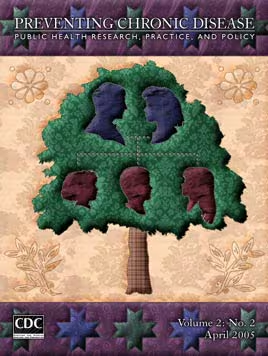 |
|
||||||||
|
|
| Home |
Volume 2: No. 2, April 2005

|
||
For our genomics issue, we reflect on the enduring family history that shapes and influences genomics public health research. The importance of the family tree in genomics is demonstrated in several of the articles in this issue as a valuable way to determine individual health risks for chronic disease. The quilt itself is a metaphor for a family’s legacy; a quilt is as unique as an individual’s genetic make-up, yet it is also made up of blocks of information — names, dates, and faces embroidered into the quilt’s pattern — that inform each family member about the others. The whole of the quilt’s design is more than the sum of its parts, and each contribution to the pattern is critical to the overall design. Beyond the quilt’s symbolism of the uniqueness of a family’s history, the quilt as a work of art is a literal reminder of one’s lineage, a family story that endures through generations.
Cover artist: Kristen Immoor
Send feedback to artist
|
|
|
|
|
|
The opinions expressed by authors contributing to this journal do not necessarily reflect the opinions of the U.S. Department of Health and Human Services, the Public Health Service, the Centers for Disease Control and Prevention, or the authors’ affiliated institutions. Use of trade names is for identification only and does not imply endorsement by any of the groups named above.
Privacy Policy | Accessibility This page last reviewed October 25, 2011
|
|